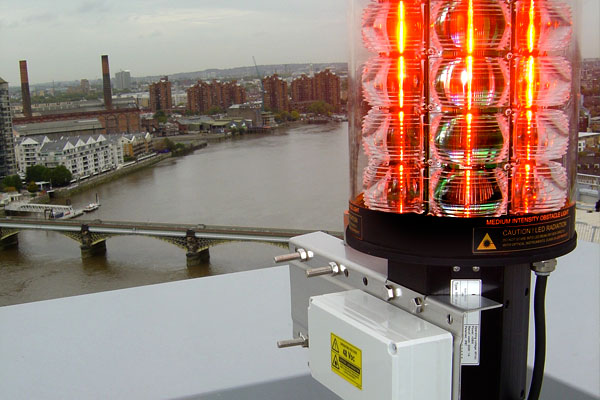Confused?...
Legislation and rules explained for Obstruction Lights & Obstacle Lighting (Aircraft Warning Lights)
We aim to advise where necessary in this matters. Explain the CAA statutory regulatory CAP rules such Article 219, ICAO Annex 14, FAA, non-regulatory requirements such as nearby aerodromes, search and rescue, helicopter routings, MOD military low flying requirements and how these may affect the safeguarding of your vertical structure.
From tall buildings, meteorological/radio masts, radar towers, wind turbines to bridges, which aviation warning lights will I need?
At CEL we will advise on a case by case basis!
Call or Email our team today!
 Article 219 Policy Statement
Article 219 Policy Statement
Lighting of En-Route Obstacles and Onshore Wind Turbines
![]() MOD lighting guidance infra red turbines onshore offshore Nov 2014
MOD lighting guidance infra red turbines onshore offshore Nov 2014
![]() ‘Policy Statement’ Lighting of En-Route Obstable and Onshore Wind Turbines’
‘Policy Statement’ Lighting of En-Route Obstable and Onshore Wind Turbines’
1 Scope and Definition
1.1 In addition to the statutory requirements for the lighting of onshore en–route obstacles in the UK, as set out at Article 219 of the UK Air Navigation Order (ANO) 20091 (available at http://www.caa.co.uk/docs/33/CAP393.pdf), this Policy Statement provides an overview of the more generic need for aviation warning lighting on tall structures and
onshore wind turbines2.
1.2 Article 219 defines an “en-route obstacle” as any building, structure or erection which is 150 meters or more above ground level, excluding any building, structure or erection
which is:
a. In the vicinity of a licensed aerodrome, and
b. to which section 47 of the Civil Aviation Act 1982 (warning of presence of obstacles near licensed aerodromes) applies.
2 Policy
2.1 In the UK, the need for aviation warning lights on 'tall' structures depends in the first instance upon any particular structure's location in relationship to an aerodrome. If a structure penetrates the obstacle limitation surfaces of an aerodrome it is for the aerodrome operator to assess the need for warning lights. Minimum requirements for licensed aerodromes are expressed in Civil Aviation Publication (CAP) 168 - Licensing
of Aerodromes.
2.2 Article 219 expresses the requirements for “en-route” structures (ie those away from the vicinity of a licensed aerodrome) and dictates a statutory requirement to provide aviation warning lights for structures of a height of 150 meters or more. The Article 219 specification requires that medium intensity (2000 candela) steady red lights be mounted as close as possible to the top of the structure and at intermediate levels not exceeding 52 metres. Such lighting should be displayed at night3 and be visible from all directions.
2.3 Notwithstanding the Article 219 requirement, some structures of a height of less than 150 meters might need aviation warning lights. Whilst structures of such heights are not routinely lit for civil aviation purposes, it is possible that aviation stakeholders, including the CAA, may make a case for aviation warning lighting where a structure is considered, by virtue of its location and nature, a significant navigational hazard.
2.4 In line with the above, as with any tall structure onshore, wind turbines may need aviation warning lights. Whilst it is unusual for the CAA, in isolation, to make any case for lighting, throughout the planning process associated with many wind turbine developments the Authority routinely highlights a potential lighting requirement. Such comment is made to pre-empt any related concerns that might be expressed by other aviation stakeholders; specific mention is made of potential Ministry of Defence (MoD)- perceived requirements.
2.5 If asked to comment on MoD recommendations relating to the need for aviation warning lights in respect of any particular wind turbine development, it is unlikely that the CAA would take issue with any military requirement, particularly if the recommended lighting was of low intensity. To that end, the CAA openly acknowledges that the MoD is best placed to assess the threat to military aviation operations posed by any particular wind turbine development.
3 DAP Point of Contact:
Off-Route Airspace 5
Directorate of Airspace Policy
CAA House
45-59 Kingsway
London
WC2B 6TE
Telephone: 0207 453 6545
Notes:
1 The re-issue of the ANO during January 2010 resulted a renumbering of the associated Article; without any amendment of the aviation lighting requirement for en-route obstacles, Article 133 became Article 219.
2 A Policy Statement dealing with the aviation warning lighting requirement for offshore wind turbines is published separately on the CAA DAP Website.
3 ‘Night’ is defined as the time from half and hour after sunset until half an hour before sunrise.
E&OE. Contarnex have provided the above information as a guide, please ensure you check the latest legislation with the correct governing body.





